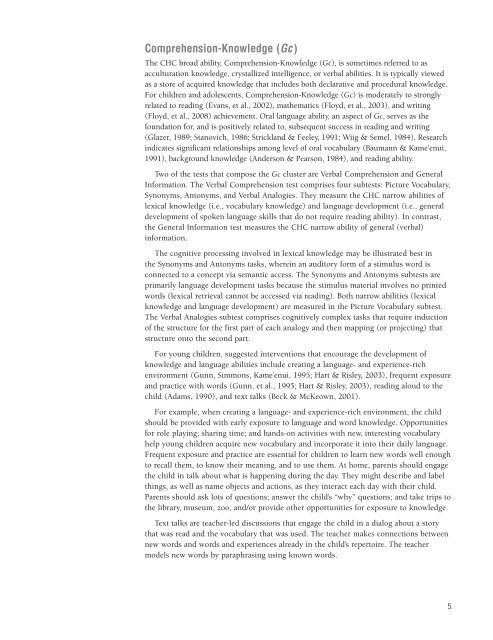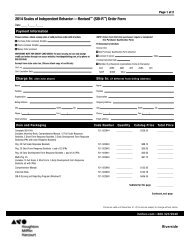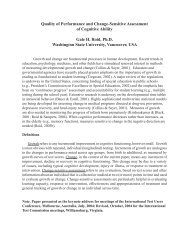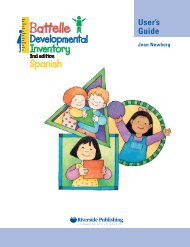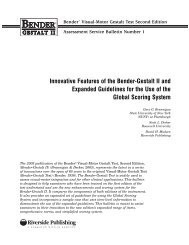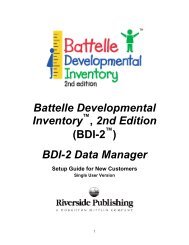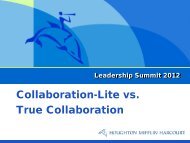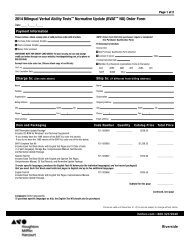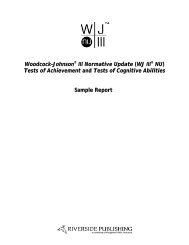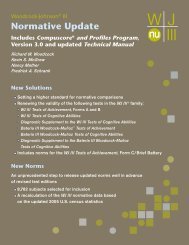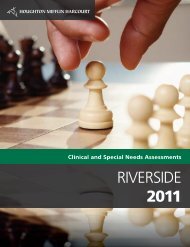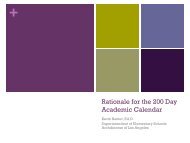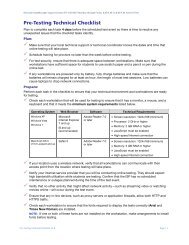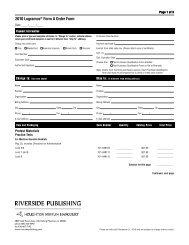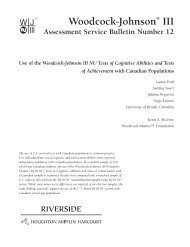Woodcock- Johnson III Tests of Cognitive Abilities - Riverside ...
Woodcock- Johnson III Tests of Cognitive Abilities - Riverside ...
Woodcock- Johnson III Tests of Cognitive Abilities - Riverside ...
Create successful ePaper yourself
Turn your PDF publications into a flip-book with our unique Google optimized e-Paper software.
Comprehension-Knowledge (Gc )The CHC broad ability, Comprehension-Knowledge (Gc), is sometimes referred to asacculturation knowledge, crystallized intelligence, or verbal abilities. It is typically viewedas a store <strong>of</strong> acquired knowledge that includes both declarative and procedural knowledge.For children and adolescents, Comprehension-Knowledge (Gc) is moderately to stronglyrelated to reading (Evans, et al., 2002), mathematics (Floyd, et al., 2003), and writing(Floyd, et al., 2008) achievement. Oral language ability, an aspect <strong>of</strong> Gc, serves as thefoundation for, and is positively related to, subsequent success in reading and writing(Glazer, 1989; Stanovich, 1986; Strickland & Feeley, 1991; Wiig & Semel, 1984). Researchindicates significant relationships among level <strong>of</strong> oral vocabulary (Baumann & Kame’enui,1991), background knowledge (Anderson & Pearson, 1984), and reading ability.Two <strong>of</strong> the tests that compose the Gc cluster are Verbal Comprehension and GeneralInformation. The Verbal Comprehension test comprises four subtests: Picture Vocabulary,Synonyms, Antonyms, and Verbal Analogies. They measure the CHC narrow abilities <strong>of</strong>lexical knowledge (i.e., vocabulary knowledge) and language development (i.e., generaldevelopment <strong>of</strong> spoken language skills that do not require reading ability). In contrast,the General Information test measures the CHC narrow ability <strong>of</strong> general (verbal)information.The cognitive processing involved in lexical knowledge may be illustrated best inthe Synonyms and Antonyms tasks, wherein an auditory form <strong>of</strong> a stimulus word isconnected to a concept via semantic access. The Synonyms and Antonyms subtests areprimarily language development tasks because the stimulus material involves no printedwords (lexical retrieval cannot be accessed via reading). Both narrow abilities (lexicalknowledge and language development) are measured in the Picture Vocabulary subtest.The Verbal Analogies subtest comprises cognitively complex tasks that require induction<strong>of</strong> the structure for the first part <strong>of</strong> each analogy and then mapping (or projecting) thatstructure onto the second part.For young children, suggested interventions that encourage the development <strong>of</strong>knowledge and language abilities include creating a language- and experience-richenvironment (Gunn, Simmons, Kame’enui, 1995; Hart & Risley, 2003), frequent exposureand practice with words (Gunn, et al., 1995; Hart & Risley, 2003), reading aloud to thechild (Adams, 1990), and text talks (Beck & McKeown, 2001).For example, when creating a language- and experience-rich environment, the childshould be provided with early exposure to language and word knowledge. Opportunitiesfor role playing; sharing time; and hands-on activities with new, interesting vocabularyhelp young children acquire new vocabulary and incorporate it into their daily language.Frequent exposure and practice are essential for children to learn new words well enoughto recall them, to know their meaning, and to use them. At home, parents should engagethe child in talk about what is happening during the day. They might describe and labelthings, as well as name objects and actions, as they interact each day with their child.Parents should ask lots <strong>of</strong> questions; answer the child’s “why” questions; and take trips tothe library, museum, zoo, and/or provide other opportunities for exposure to knowledge.Text talks are teacher-led discussions that engage the child in a dialog about a storythat was read and the vocabulary that was used. The teacher makes connections betweennew words and words and experiences already in the child’s repertoire. The teachermodels new words by paraphrasing using known words.


